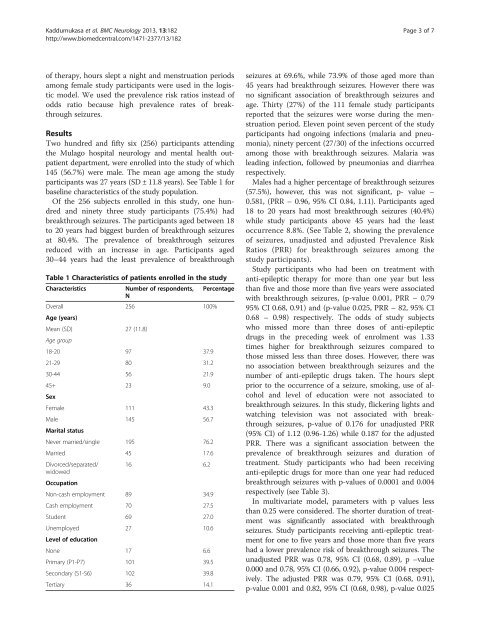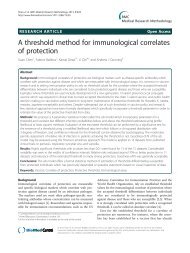The frequency and precipitating factors for breakthrough seizures ...
The frequency and precipitating factors for breakthrough seizures ...
The frequency and precipitating factors for breakthrough seizures ...
You also want an ePaper? Increase the reach of your titles
YUMPU automatically turns print PDFs into web optimized ePapers that Google loves.
Kaddumukasa et al. BMC Neurology 2013, 13:182 Page 3 of 7<br />
http://www.biomedcentral.com/1471-2377/13/182<br />
of therapy, hours slept a night <strong>and</strong> menstruation periods<br />
among female study participants were used in the logistic<br />
model. We used the prevalence risk ratios instead of<br />
odds ratio because high prevalence rates of <strong>breakthrough</strong><br />
<strong>seizures</strong>.<br />
Results<br />
Two hundred <strong>and</strong> fifty six (256) participants attending<br />
the Mulago hospital neurology <strong>and</strong> mental health outpatient<br />
department, were enrolled into the study of which<br />
145 (56.7%) were male. <strong>The</strong> mean age among the study<br />
participants was 27 years (SD ± 11.8 years). See Table 1 <strong>for</strong><br />
baseline characteristics of the study population.<br />
Of the 256 subjects enrolled in this study, one hundred<br />
<strong>and</strong> ninety three study participants (75.4%) had<br />
<strong>breakthrough</strong> <strong>seizures</strong>. <strong>The</strong> participants aged between 18<br />
to 20 years had biggest burden of <strong>breakthrough</strong> <strong>seizures</strong><br />
at 80.4%. <strong>The</strong> prevalence of <strong>breakthrough</strong> <strong>seizures</strong><br />
reduced with an increase in age. Participants aged<br />
30–44 years had the least prevalence of <strong>breakthrough</strong><br />
Table 1 Characteristics of patients enrolled in the study<br />
Characteristics<br />
Number of respondents, Percentage<br />
N<br />
Overall 256 100%<br />
Age (years)<br />
Mean (SD) 27 (11.8)<br />
Age group<br />
18-20 97 37.9<br />
21-29 80 31.2<br />
30-44 56 21.9<br />
45+ 23 9.0<br />
Sex<br />
Female 111 43.3<br />
Male 145 56.7<br />
Marital status<br />
Never married/single 195 76.2<br />
Married 45 17.6<br />
Divorced/separated/ 16 6.2<br />
widowed<br />
Occupation<br />
Non-cash employment 89 34.9<br />
Cash employment 70 27.5<br />
Student 69 27.0<br />
Unemployed 27 10.6<br />
Level of education<br />
None 17 6.6<br />
Primary (P1-P7) 101 39.5<br />
Secondary (S1-S6) 102 39.8<br />
Tertiary 36 14.1<br />
<strong>seizures</strong> at 69.6%, while 73.9% of those aged more than<br />
45 years had <strong>breakthrough</strong> <strong>seizures</strong>. However there was<br />
no significant association of <strong>breakthrough</strong> <strong>seizures</strong> <strong>and</strong><br />
age. Thirty (27%) of the 111 female study participants<br />
reported that the <strong>seizures</strong> were worse during the menstruation<br />
period. Eleven point seven percent of the study<br />
participants had ongoing infections (malaria <strong>and</strong> pneumonia),<br />
ninety percent (27/30) of the infections occurred<br />
among those with <strong>breakthrough</strong> <strong>seizures</strong>. Malaria was<br />
leading infection, followed by pneumonias <strong>and</strong> diarrhea<br />
respectively.<br />
Males had a higher percentage of <strong>breakthrough</strong> <strong>seizures</strong><br />
(57.5%), however, this was not significant, p- value –<br />
0.581, (PRR – 0.96, 95% CI 0.84, 1.11). Participants aged<br />
18 to 20 years had most <strong>breakthrough</strong> <strong>seizures</strong> (40.4%)<br />
while study participants above 45 years had the least<br />
occurrence8.8%.(SeeTable2,showingtheprevalence<br />
of <strong>seizures</strong>, unadjusted <strong>and</strong> adjusted Prevalence Risk<br />
Ratios (PRR) <strong>for</strong> <strong>breakthrough</strong> <strong>seizures</strong> among the<br />
study participants).<br />
Study participants who had been on treatment with<br />
anti-epileptic therapy <strong>for</strong> more than one year but less<br />
than five <strong>and</strong> those more than five years were associated<br />
with <strong>breakthrough</strong> <strong>seizures</strong>, (p-value 0.001, PRR – 0.79<br />
95% CI 0.68, 0.91) <strong>and</strong> (p-value 0.025, PRR – 82, 95% CI<br />
0.68 – 0.98) respectively. <strong>The</strong> odds of study subjects<br />
who missed more than three doses of anti-epileptic<br />
drugs in the preceding week of enrolment was 1.33<br />
times higher <strong>for</strong> <strong>breakthrough</strong> <strong>seizures</strong> compared to<br />
those missed less than three doses. However, there was<br />
no association between <strong>breakthrough</strong> <strong>seizures</strong> <strong>and</strong> the<br />
number of anti-epileptic drugs taken. <strong>The</strong> hours slept<br />
prior to the occurrence of a seizure, smoking, use of alcohol<br />
<strong>and</strong> level of education were not associated to<br />
<strong>breakthrough</strong> <strong>seizures</strong>. In this study, flickering lights <strong>and</strong><br />
watching television was not associated with <strong>breakthrough</strong><br />
<strong>seizures</strong>, p-value of 0.176 <strong>for</strong> unadjusted PRR<br />
(95% CI) of 1.12 (0.96-1.26) while 0.187 <strong>for</strong> the adjusted<br />
PRR. <strong>The</strong>re was a significant association between the<br />
prevalence of <strong>breakthrough</strong> <strong>seizures</strong> <strong>and</strong> duration of<br />
treatment. Study participants who had been receiving<br />
anti-epileptic drugs <strong>for</strong> more than one year had reduced<br />
<strong>breakthrough</strong> <strong>seizures</strong> with p-values of 0.0001 <strong>and</strong> 0.004<br />
respectively (see Table 3).<br />
In multivariate model, parameters with p values less<br />
than 0.25 were considered. <strong>The</strong> shorter duration of treatment<br />
was significantly associated with <strong>breakthrough</strong><br />
<strong>seizures</strong>. Study participants receiving anti-epileptic treatment<br />
<strong>for</strong> one to five years <strong>and</strong> those more than five years<br />
had a lower prevalence risk of <strong>breakthrough</strong> <strong>seizures</strong>. <strong>The</strong><br />
unadjusted PRR was 0.78, 95% CI (0.68, 0.89), p –value<br />
0.000 <strong>and</strong> 0.78, 95% CI (0.66, 0.92), p-value 0.004 respectively.<br />
<strong>The</strong> adjusted PRR was 0.79, 95% CI (0.68, 0.91),<br />
p-value 0.001 <strong>and</strong> 0.82, 95% CI (0.68, 0.98), p-value 0.025
















